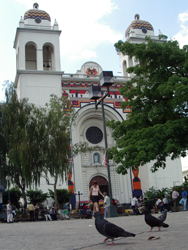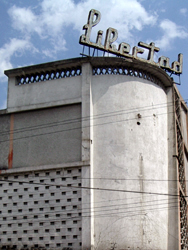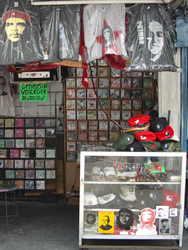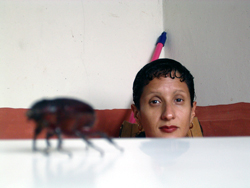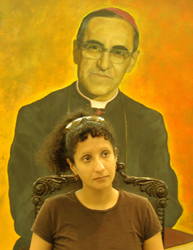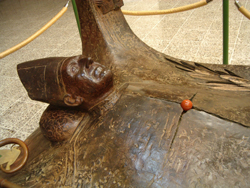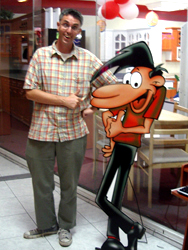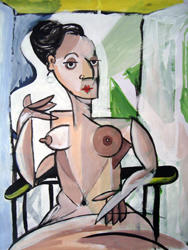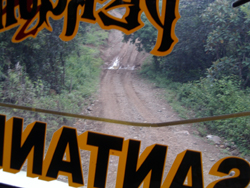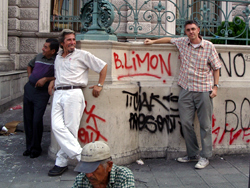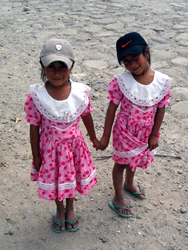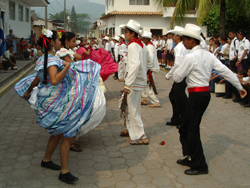Maps, Martyrs and Mud
Dispatch from El Salvador - May 2005

| The Country Next Door After 12 years
of the bloodiest civil war in Central American history, one would expect
El Salvador to be in a bit of a mess. The war cost about 80,000 lives,
uprooted about 1 million people, and destroyed the country's productive
infrastructure. Mixed in with an earthquake (2001) and a hurricane (1998)
this would not normally bode well for a developing country. However,
amazingly, just 13 years since the signing of peace accords it is flourishing
economically albeit with the usual social inequalities (many of the
population still live in abject squalor) and political “inconsistencies”
(the party of the military and ruling elite has been the only one to
be elected). It is the most industrialized country in Central America
with arguably the most industrious people. It’s also the most
deforested. There are very few visible signs of the civil war excepting
the plethora of limbless street dwellers. |
|
|
|
We saw comical Mohican-baring punks strut the streets, surely a healthy indication of social tolerance in any society. Gnarly youth sporting hipster clothing, facial piercings and arty tattoos stand out as the public façade of a vibrant underground culture (sadly mostly exported en masse from el norte) whilst chic cafés and art bars line edgy neighborhoods. Regrettably, one hip hangout we frequented had a Guns ‘n’ Roses cover band performing but it’s still one step up from the mind numbing and uncreative genre that is known as “Reggaeton” on the musical evolutionary scale (in the same way a water flea is one step up from an amoeba). Unlike Honduras, very few women walk around with parasitic babies hanging from their lactating nipples (my new index indicator for a healthy birth rate). In fact, in many parts of the capitol, San Salvador, you could be excused for thinking you were in some of the ritzier areas of Los Angeles. It follows then that El Salvador is one of the most violent and crime-ridden countries in Latin America. Nonetheless, I found it refreshingly stimulating and reassuringly positive. |
| A Quick Peep at the Pipils El Salvador was first settled by the Pipil who now comprise only 1% of the population because they were massacred in turn first by the Spanish and much later the CIA. The seven day massacre by the government of 30,000 rebelling Pipil in 1932 known as “La Matanza” wiped out complete villages of Pipil including anyone wearing indigenous clothing, anyone who spoke Nahuat or anyone who even looked indigenous thus beginning sixty straight years of oppressive military rule.
|
|
|
The
first export crop was the color purple in the form of indigo crops.
This was soon surpassed by coffee and more recently by remittances sent
by family members in the US. Sadly the British have abandoned El Salvador
(along with Honduras) and closed their embassy (along with the adjoining
British pub). El Salvador has the greatest Pilsner beer in the Americas—perceptibly
named “Pilsener” (sic)—thanks in part to it’s
German heritage, even more so when served in a frosted glass. In El
Salvador I had a sudden revelation. It occurred to me that the reason
that the hot and cold water faucets (taps) are reversed in Latin America
is because when the US made plumbing arrives marked “C”
and “H” they are designated “caliente” (hot)
and “Helado” (freezing). Of course there is rarely this
choice of water temperature because all water here is “T”
(tepido) but it’s a conversation gap filler. |
| The Mad Dictator It’s bad enough having a fierce and brutal dictator ruling your country but when the dictator turns out to be fit for the nut house it can’t really get any worse. Maximiliano Hernández Martínez (1882-1966) was known as “El Brujo” (the wizard) due to his beliefs in all things mystical and magic. He hung red lamps in villages to cure diseases and proclaimed that science was wrong and that in reality there are ten senses (hunger, thirst, procreation, urination and bowel movements if you were wondering). He also believed it was a much greater crime to kill an ant than a person because while a man has an eternal soul an ant is dead forever. Children were not spared the craziness and were instructed to go barefoot to better receive the beneficial emanations of the earth. “Plants and animals don’t use shoes” he said. In a fitting end he was stabbed to death by his chauffeur whilst in exile in Honduras aged 88. |
|
|
One of the many victims of the mad dictator was Augusto Farabundo Martí (1893-1932) a close pal of Augusto Sandino in Nicaragua but whereas Sandino was fighting for Nicaraguan Nationalism, Martí (not to be confused with his Cuban namesake) was more of an ideological socialist. His name lives on in the FMLN movement. |
The Bloody War The CIA backed government killed tens of thousands of innocent people and set US-trained right wing death squad to slaughter and wipe out the opposition. Government forces errantly massacred over a thousand men, women, and children in El Mozote and surrounding hamlets in December 1981. The death squads were also blamed for killing thousands of civilians, including Jesuit priests, nuns, labor organizers, peasant leaders, alleged “communists”, and democratic reformers. History has shown that killing nuns, especially US ones will never win you International support. |
|
|
The FMLN staged an attempted revolution of sorts under the dubious slogan of “Either we all eat or no one eats”. Supported by Cuba and Nicaragua, the leftist guerrilla rebels operated mainly in the countryside, raiding towns, police stations, and military posts to obtain arms and gaining control of about a third of the country. After disrupting food supplies, destroying 70 bridges and 35% of the busses in addition to sabotaging water and electricity supplies, it’s not hard to see why the population grew weary of these desperate tactics after 12 years. The rebels also mistakenly killed Roque Dalton García, El Salvador’s greatest poet and FMLN sympathizer in the belief he was a CIA spy. After the ceasefire established by the 1992 Chapultepec Peace Accords, the FMLN became a legitimate political party but has so far failed to defeat the right-wing ARENA party who despite (or perhaps because of) their connection with the US and the CIA trained death squads have won the three “democratic” US endorsed elections held since. |
Archbishop Óscar Romero is the other great El Salvadoran hero. He was shot down in 1980 whilst preaching mass in front of a congregation in the chapel of a cancer hospital because of his support of the poor and his pro FMLN socialist stance against the government. He is now a hero of liberation theologists around the globe (including all three nuns in our town of Zacapa who made a pilgrimage to the 25th anniversary of his murder on March 24th). His tomb is in the dingy basement of the cathedral in San Salvador among stacks of dusty plastic chairs. Cast in bronze it looks like Harrison Fords temporary tomb in The Empire Strikes Back combined with an upside down bed. There is across-shaped crack in the chestal area from which what seems like a tomato is emerging. Awesome. |
|
|
|
Transport The bus system in El Salvador is outstanding. You can zip all over the country and around the cities quickly and for next to nothing. In a country as compact and as populated as El Salvador this is an obvious benefit. The roads are in excellent condition compared to the rest of Central America. This has also resulted in very little private traffic on the roads and here there are taxis they are super cheap. El Salvador is not immune to the obligatory bus venders though, although one bus we traveled on had a man hawking underwear.
|
The Mall of Malls The
Metrocentro in San Salvador is the biggest “mall” in Central
America. It is also bigger than most medium sized cities. It is built
on the side of a hill and has eleven (eleven!!) sprawling erratic levels!
You can easily get lost in the place, especially as the stores—which
represent the only navigational reference points—start repeating
themselves after a while. It’s globalization at its worst with
only the richest Salvadorans being able to meet the extreme prices for
what seemed like exclusively imported goods Meanwhile, the huddled masses
circle the perimeter with longing before descending upon the chaos and
anarchy of the street markets which at least offer something approaching
home made fare. The mall did surprisingly have a theater (even unfettered
capitalism sometimes has to make some concession to the arts) and we
were able to enjoy an amusing but brief (“Is that the Interval
or is it over?”) Venezuelan comedy entitled “Divorciadas,
Evangélicas y Vegetarianas” |
|
|
|
Rabid
fans
|
|
|
|
Thus, it was even more surprising to catch a bus that drove from Honduras into El Salvador and back without so much as a passport control or a customs area. Just a river marks the blind spot on the border. Splash through that and you’re in a different country. Okay it’s not exactly the direct route and the muddy “road” is enough to deter all but four-wheel drives and the adventurous—it’s impassable four months of the year—but it still gives you the exciting feeling of subterfuge that you might get by, say, slightly changing your signature when signing a bank check or taking a photograph in a museum. One more strike against authority. |
| Misery
is happiness
After such a barbaric legacy, why do so many people in Latin America still love the US and pursue the “American dream”? I ask myself this question on a daily basis, partly because I can find no rational answer (Stockholm Syndrome, decades of fabulous PR and lack of a better alternative are the closest three I can find) but mostly because I myself followed that same reasoning back when I was a European boy shackled by the British class-system and the destroying of all that was good about England in the 80s by one of the biggest political tyrants of all, Margaret Thatcher. |
|
|
|
Happiness is Misery I
was an avid consumer of current affairs and world history so I can’t
plead ignorance when it comes down to decisions made in the past. I
had plenty of logically more attractive alternatives available. All
I can say is that the reality of the situation I discovered in California
led me to Honduras where despite everything seeming hopeless and the
future of the country as dim as ever there is something here that you
can never find in the states and whatever that something is, it’s
strong enough to make me wonder if I can ever go back. |
Life is a Map My
new project is traveling around the country making cartoon eco-tourism
maps. I’ve done three so far and there are six more to go until
our time here is done. It’s a good way to see the country (all
expenses paid!) and it’s instant gratification. Honduras is badly
lacking in tourist infrastructure. The Honduran Tourism Institute has
finally come round to see that good marketing is essential to selling
the “beauty of Honduras in a way that Costa Rica was able to sell
itself as the “prime destination in Central America” when
it actually lacks any kind of culture and tourism. |
|
|
It's all a matter of perspective That’s where I come in. It helps to look at things on the positive side of course. Ignoring the mountains of trash and streets lined with clusters of heartbreaking poor and disabled is first and foremost when drawing a colonial cathedral of course. It’s all a question of perspective. Perhaps it’s good for such a cynic like me to be involved in something like this. Honduras can actually resemble a beautiful county when viewed through lemon-colored spectacles. |
In Limbo Yes. We’re almost done. The number of months left in Honduras can finally be counted on the fingers of one hand. It’s an odd sensation… a bit like being fired from a job and being given five months notice. Planning the future goes so far and then it stops at the unknown. What we will do next is still very much up in the air like a balloon with a leak. Keep
your eyes peeled and your browsers bookmarked for the next exciting
dispatch from your favorite Central American correspondent. |
|

Previous dispatch | Next dispatch
©
J. Lemon / Lemonworld 2005. All rights reserved. This
web site is not an official publication of the Peace Corps or the U.S.
Government. The contents of this Web site reflect the personal opinions
and observations of the individual(s) contributor(s) and do not reflect
any position of the U.S. Government or the Peace Corps. |
